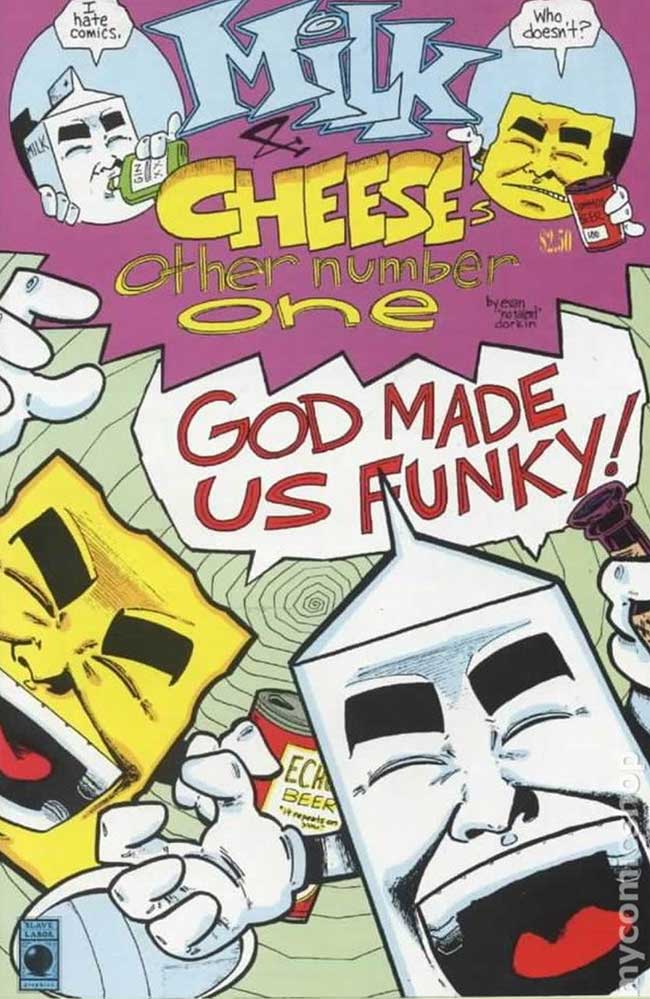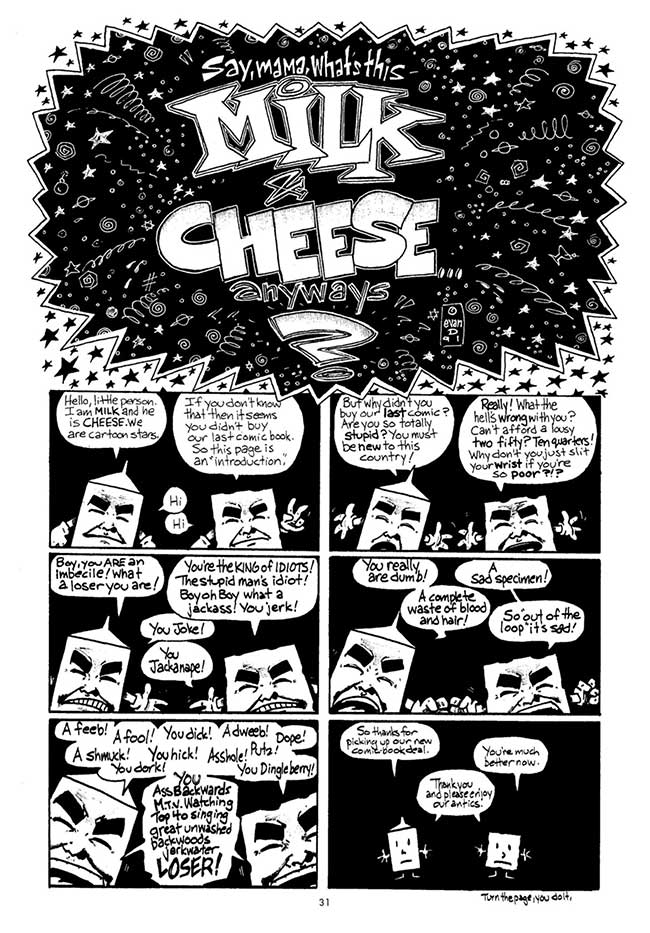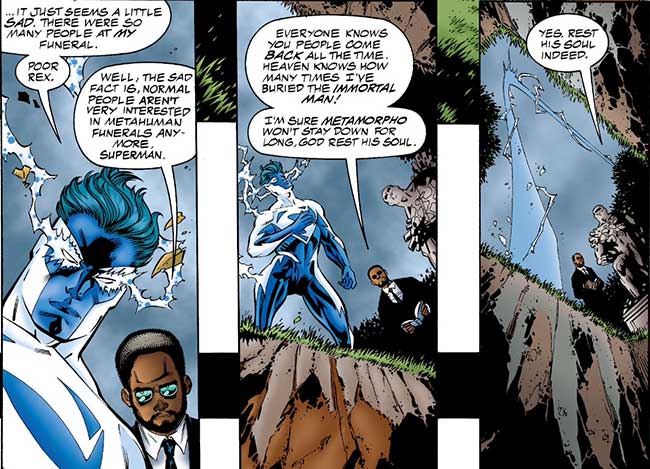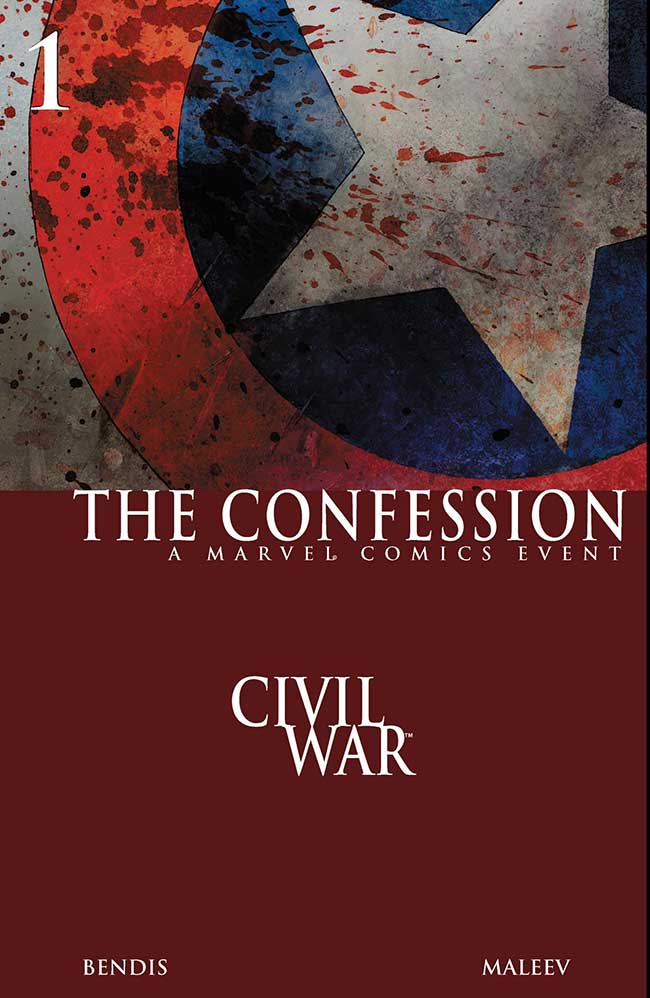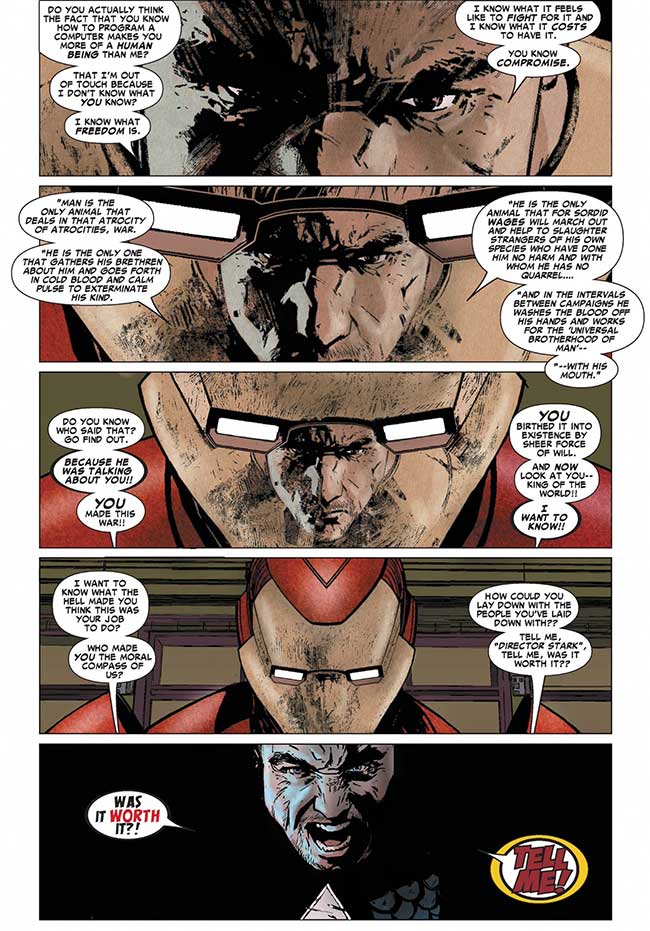Rand Bellavia is back to share his fond memories of decades of comic collecting and reading in this month’s Random Access Memory.
Author’s Note: Random Access Memory is me looking back at the specific comics that shaped my life. Each month I go back in time – in five year intervals – to examine key comics that came out those months. (The idea is that after five years of monthly columns, I will have covered an entire lifetime – in this case, fifty years – of reading comics.) I also list all the comics I read that particular month. This will afford readers the opportunity to chastise me for not reading specific comics, and/or laugh at the horrible, horrible choices I made in the past.
March 1977
Avengers 160
My first exposure to Simon Williams (aka Wonder Man) was seeing his reanimated corpse bursting through a huge wooden crate at the end of Avengers 151. Nine issues later, his complex relationship with the Avengers is spelled out in one glorious stand-alone tale. Jim Shooter condensed a tremendous amount of continuity into this issue, and the fact that I was aware of none of it before, yet it all made some form of sense to me would indicate it was a successful effort on his part. There’s a lot of story here, but the focus is mostly on the relationship between Simon, his brother Eric – Avengers villain the Grim Reaper – and their “brother” the Vision, the synthezoid whose artificial brain was programmed using (the then-dead) Simon’s brain patterns.
But the real star here is George Perez. His deft camera shifts and swirls around the action, continuously providing the reader with the perfect angle for every panel, while never sacrificing storytelling clarity.
Simon begins this issue wearing the costume he died in, way back in Avengers 9, and while Eric’s violent attack on Simon and the Avengers may have been wrongheaded, he should at least be given credit for destroying that monstrosity, and setting Simon on the path that would eventually lead (two costumes later) to the Leisure Suit he was born to wear.
But it would be remiss of me to walk away without mentioning the most famous page from this issue:
How Perez penciled the transition from panel two to panel three without noticing the obvious continuity error is anyone’s guess, but it has become one of the most infamous art gaffes of the Bronze Age.
Other Comics I Read From March 1977
- Invaders 17
- Marvel Tales 80
- Marvel Team Up 58
- Peter Parker the Spectacular Spider-Man 7
- Spidey Super Stories 23
- Super-Team Family 11
March 1982
Amazing Spider-Man 229
This was my first exposure to the Juggernaut, and Roger Stern and John Romita, Jr. do an amazing job of selling a very simple concept: What happens when the hero who won’t give up encounters a foe who can’t be stopped? The issue boils down a single plot thread: Juggy is walking toward Madame Web’s apartment, and Spidey is trying to stop him from getting there.
Spoiler warning: Nothing can stop the Juggernaut.
Amazing Spider-Man 230
And, we pick up where 229 left off, with an angry and grieving Spidey still trying to stop the Juggernaut – this time from escaping punishment for his crime. After exhausting his typical bag or tricks (speed, strength, webbing, etc.), Spidey resorts to more drastic measures:
And when it becomes abundantly clear that Juggy just can’t be stopped, Spidey latches on for all he’s worth and awaits the end.
But, since this isn’t The Night Gwen Stacy Died, things end reasonably well for our hero.
Captain America 270
In this issue, J. M. DeMatteis introduces us to Arnold Roth, Steve Rogers’ childhood best friend.
Fans of the Marvel movie universe will no doubt recognize Roth as the character that was conflated with James Barnes to create the cinematic Bucky.
In this story we also meet Arnie’s “roommate” Michael.
While it is hinted at here has a great payoff, as later issues make it fairly obvious (or, as obvious as was allowed in an early 80s Marvel comic) that Arnie and Michael are lovers, and Captain America’s acknowledgement and support of Arnie’s relationship with Michael was a huge step for Marvel to take. Sadly, it would take another decade for Marvel to officially “out” one of their heroes. Even sadder, it was the fairly unlikable (and suitably unpopular) Alpha Flight character Northstar.
Cerebus 36
The last time Jaka and Cerebus were together, he was a poor barbarian hopelessly in love with her. Now, as Prime Minister, Jaka comes to Cerebus, and they have an uncomfortable conversation.
Jaka admits that she has been suffering under pecuniary straits, largely due to an ill-advised purchase:
Eventually, Jaka reveals that she came not to beg anything from Cerebus, but rather to give him something.
Then Jaka leaves Cerebus to unwrap his gift.
Other Comics I Read from March 1982
- Avengers 220
- Captain America 270
- Daredevil 184
- Fantastic Four 243
- Fury of Firestorm 1
- Ka-Zar 16
- Marvel Super-Hero Contest of Champions 1
- Marvel Team-Up 118
- Nexus 2
March 1987
America Flagg 42
Rueben Flagg’s is a Plexus Ranger, and his partner is Luther Ironheart, a large robot with a pink holographic head. Luther is hopelessly naïve, to the point of appearing unintelligent, and is often played for comic relief.
Having discovered another artificial life form, Luther abandons Rueben to help his new friend bring older, non-functioning robots back to “life.” And he succeeds, just in time for Rueben to return in need of assistance:
Of course the robots agree to help Rueben escape – and of course they are all destroyed.
Luther and his new friend have a conversation about religion and service.
And of course, Luther’s robot friend sacrifices himself to save Luther and Rueben. Or does he?
Finally, Luther takes one giant, horrifying leap toward humanity.
Flash 1
This issue marks the first appearance of Wally West as The Flash, as his mentor – Barry Allen, the Silver Age Flash – had just died heroically defeating the plans of the Anti-Monitor during the Crisis on Infinite Earths. (That’s the kind of sentence that really brings into focus just how much of my life I’ve wasted reading comic books.) Wally’s initial adventures as the Flash were written by Mike Baron, whose indy books Nexus and Badger were turning heads at the time. His greatest contribution to the Flash canon appears to have been the whole “I have to eat all the time since I’m constantly burning calories” riff.
Looking at the book today, it appears to represent pretty much everything wrong-headed about the “realistic” turn comics took in the mid-80s.
The Flash was *the* major death of Crisis on Infinite Earths, and here we have the post-Crisis launch issue of the legacy character, and the main story involves Wally using his super-speed to transport a transplant organ across the country. And it gets worse.
Honest to God, the first appearance of Wally West as The Flash boils down to, “The Flash gets health insurance.” Don’t get me wrong, I like it when Spidey has trouble making ends meet, but usually – while Peter is swinging around the city wondering how to pay Aunt May’s hospital bills – The Vulture or Stilt-Man interrupt with a plot, or at least a fight sequence.
Justice League 2
And then J.M. DeMatteis and Keven Maguire show you how to take a comic with a thin plot, and make it work. The early issues of the post-Crisis Justice League relaunch were essentially Guy Gardner acting out and then muttering under his breath when Batman put him in his place. But the script was great and the facial expressions were priceless.
Here’s one of my favorite panels ever:
Marvel Graphic Novel: Emperor Doom
What if Dr. Doom used The Purple Man to take over the world? And what if the world appeared to be better off for it? The perennially underrated David Michelinie hits it out of the park with this original graphic novel – illustrated by the always great Bob Hall – which casts a narrative shadow reaching all the way to last year’s Secret Wars cross-over.
Wonder Man gets some screen time as the point-of-view character here, when Iron Man asks him to volunteer for a Plot Device/Lengthy Sensory Deprivation experiment. This means that he alone is spared the ravages of the Purple Man’s mind control. He emerges to find a world devoid of war, crime, and poverty, ruled by the (literally) iron fist of Doctor Doom.
Not sure what to do, he does what any of us would: he wakes up Captain America.
Together they quickly hatch a plot to “wake up” who they consider to be the strongest willed members of the Avengers: Hawkeye, the Wasp, and Iron Man. Having formed their team, they head off to save the world.
This book does a good job – a fantastic job when you stop to consider the audience it was aimed at and the political climate of the late 80s – of addressing the bind these heroes find themselves in. Cap is really the only one who is utterly convinced that freedom of choice is more important than freedom from starvation and war.
Eventually, of course, our heroes are victorious, but – most interestingly – this victory comes at least in part through the inaction/indecision of Doctor Doom himself.
Doom has considered the possibility of an uprising and prepared a clear method for putting it down. Yet he can’t bring himself to push the button. His reasons aren’t fully explored – self-doubt, moral clarity, boredom?
So, the world goes back to the way it was, leaving five Avengers (and Doctor Doom) to wrestle with the implications of their actions for the rest of their lives.
Question 5
After a fairly rocky start – writer Denny O’Neil pushed the reader’s suspension of disbelief a bit too far on the debut issue (the clearly human lead character was shot in the head and drowned, but somehow gets better in issue two) – issue five finds everything working perfectly. O’Neil’s Zen take on Victor Sage is firmly in place, and the art really gels this issue, with penciler Denys Cowan and inker Rick Maygar coalescing to form one of the unsung art teams of the late 80s.
Part of what makes this issue so great is that – for the most part – the Question sits this one out. The story focuses on several minor characters throughout Hub City, and how their lives are irrevocably changed by an unexpected storm.
The storm creates the opportunity for Bernie Josephson to commit a foul act. His guilt causes him to commit suicide, which inadvertently leads to the salvation of a dirty cop.
The Question is (literally) just along for the ride. And his dialog reads like it was written yesterday.
Other Comics I Read from March 1987
- Alien Legion 19
- Amazing Spider-Man 289, 290
- Avengers 280
- Badger 26
- Chronicles of Corum 4
- Classic X-Men 10
- Concrete 1
- Detective Comics 575
- Dreadstar 31
- Grendel 6
- Incredible Hulk 332
- Nexus 35
- Scout 17
- Swamp Thing 61
- Vigilante 42
- X-Men vs. the Avengers 4
March 1992
Milk and Cheese’s Other Number One
Milk and Cheese is one of those “you either get it or you don’t” concepts. In the early 90s someone working for the TV show Rosanne got it, and Evan Dorkin made a lot more money than he might have otherwise.
When this, their second issue, came out – all of the issues are annoyingly titled based on their relationship to the first issue rather than in a clear numeric sequence (issue three is “Milk and Cheese’s Third Number One,” etc.) – our favorite Carton of Hate and Wedge of Spite were still unknown enough that they merited this introductory page:
And that’s basically it. A humorously illustrated carton of milk and hunk o’ cheese looking angry, insulting the audience, and – eventually – violently attacking every character who has the misfortune of wandering into the frame.
Get it?
Shade the Changing Man 23
I was never a huge fan of the Vertigo post-McKean photo cover trend, but this one really works for me.
Milligan’s dialog and Bachelo’s facial expression work here match quite nicely – all betraying the very dark storyline that is bubbling under the surface, and will be revealed in the final two issues of the storyline.
Other Comics I Read from March 1992
- Animal Man 47
- Cerebus 156
- Detective Comics 643
- Doom Patrol 54
- Eightball 8
- Flash 62, 63
- Hate 8
- Hellblazer 53
- Incredible Hulk 393, Annual 18
- Legends of the Dark Knight 30
- Miracleman: Apocrypha 2
- Peter Parker the Spectacular Spider-Man 188
- Sandman 37
- Swamp Thing 119
- X-Factor 78, Annual 7
March 1997
Aztek 10
The final issue of the series. Hard to believe that a newly minted DC super-hero, co-created by Grant Morrison and Mark Millar could come to such an ignoble end, but that was mid-90s comics for you.
This issue has a great “holodeck” opening.
The immediate revelation that what we just saw was a simulation – and part of a Justice League initiation exam – is great fun, and works precisely because they don’t play with our emotions by drawing the scene out any longer than necessary.
The rest of the issue has some pretty fun stuff surrounding the Justice League’s initiation rituals, and wraps up some loose ends, allowing Aztek’s main plotline to eventually get resolved in Morrison’s JLA run.
Invisibles 4
The Black Science arc ends with a major revelation. Our heroes broke into an enemy compound expecting to find the cure for AIDS, and instead found something much more mysterious and powerful.
Ever wonder why the second half of the 20th century seemed so full of chaos? Why it felt like there was no one behind the wheel of the universe? Well, there you go. Oh, and the Roswell Aliens? Also God.
And King Mob’s reaction to finding our suffering creator is beyond perfect:
Just as the reader is starting to question King Mob’s morality, Morrison reminds us who the good guys are, and sets King Mob on the long road to redemption.
JLA 5
Membership drive! This issue starts with Metamorpho’s poorly attended funeral.
Then several pages are dedicated to the JLA job interview process. Much of this is played for laughs, including the first official JLA/Hitman crossover.
Eventually, the JLA settles on several new members, including the above mentioned Aztek, and Tomorrow Woman, an impressive new hero who is – in fact – an artificial life-form co-created by Professor’s Ivo and T.O. Morrow, with the intention of destroying the newly formed Justice League. Throughout the issue, Ivo and Morrow discuss their creation with pride, as Tomorrow Woman possesses a body (created by Ivo) and brain (created by Morrow) that could pass even the most difficult Turing Tests.
But – of course – her brain was a bit *too* well made, and – of course – just at the moment when she is meant to destroy the JLA, she overcomes her programming and sacrifices herself to save the JLA *and* defeat the bad guy.
The twist here is that this was part of Morrow’s plan all along. Unlike Ivo, he was more interested in demonstrating his intellectual superiority than he was in getting revenge on the Justice League.
Preacher 25
The Origin of Cassidy! We begin with a young, naïve Cassidy being schooled by his older brother Billy
Sadly, Cassidy never makes it home that night
After misadventures with a sheep, we return to the present, and Jesse asks the only important question
Other Comics I Read from March 1997
- Batman: The Long Halloween 6
- Cerebus 216
- Dork 4
- DV8 5
- Flash 125
- Hellblazer 113
- Hitman 14
- Impulse 25
- Ka-Zar 1
- The Shade 2
- Spectacular Spider-Man 246
- Starman 30
- Stormwatch 46
- Strangers in Paradise 4
- Supergirl 9
- Unknown Soldier 2
- Untold Tales of Spider-Man 21
- Vermillion 8
March 2002
Ultimates 3
For all the widescreen action spectacle that the Ultimates brought to the fore, it was the quiet moments that really solidified the book as the best work of Mark Millar’s career.
Steve’s reunion with Bucky and Gail is note perfect in dialog and execution.
Other Comics I Read from March 2002
- 100 Bullets 34
- Alias 7
- Amazing Spider-Man 39
- Avengers 52
- Avengers: Celestial Quest 7
- Batman 601
- Batman: Legends of the Dark Knight 153
- Cage 2
- Catwoman 5
- Daredevil 31
- Detective Comics 768
- Elektra 9
- Felon 4
- Flash 184
- Green Arrow 13
- Hawkman 1
- Hellblazer 172
- Incredible Hulk 38
- JSA 34
- Lucifer 24
- New X-Men 124
- Powers 18
- Superman 180
- Transmetropolitan 54
- Ultimate Marvel Team-Up 14
- Ultimate Spider-Man 20
- Ultimate X-Men 16
- Wolverine/Hulk 2
- X-Force 126
March 2007
Civil War: Confession
One of the unintended consequences of the Civil War cross-over is that it made it really hard to see Tony Stark as a hero. Sure, he was always sort of douchey, but Captain America vouched for him, so we assumed he was alright. With Cap his martyred enemy, and most of his friends either in jail or on the run from him, Tony’s mustache had clearly started to twirl.
Then Coach Quesada took Mark Millar off the mount, and brought in reliever Brian Michael Bendis for the save. Civil War: The Confession is Brian Michael Bendis’ single-handed attempt to rehabilitate Tony Stark. He does this with a little trick writers like to call “giving your character a clear motivation.”
The Confession is told in two chapters. The second chapter (which I am addressing first, because reasons) is a brief confrontation between Tony and Steve while Steve is in custody, shortly before his assassination. As you might guess, Steve isn’t in a good mood.
The first chapter is a Tony Stark monolog, the Confession of the title. Tony pours his heart out, explaining why he did what he did.
Alex Maleev does the heavy lifting here, portraying a weeping, repentant Tony Stark who is worthy of our pity, if not our forgiveness.
The final double-page spread delivers the gut-punch, with Tony answering Steve’s final question, presented in an overhead shot, as is the law when presenting a man weeping over his fallen comrade.
Other Comics I Read from March 2007
- 100 Bullets 82
- 52 44-47
- American Virgin 13
- Avengers: Earth’s Mightiest Heroes II 8
- Batman 664
- Brave and the Bold 2
- Bullet Points 5
- Captain America 26
- Crossing Midnight 5
- Daredevil 95
- DMZ 17
- Exterminators 15
- Ghost Rider: Trail of Tears 2
- Green Lantern 18
- Hellblazer 230
- Immortal Iron Fist 4
- Incredible Hulk 104
- JSA 4
- Loveless 17
- Midnighter 5
- Mighty Avengers 1
- New Avengers 28
- Nightly News 5
- Phonogram 5
- Powers 26
- Punisher 45
- Punisher Presents Barracuda 2
- Punisher War Journal 5
- Scalped 3
- She-Hulk 17
- Stormwatch PHD 5
- Teen Titans 45
- Testament 16
- Thunderbolts 112
- Ultimate Power 4
- Ultimate Spider-Man 106, 107
- Uncanny X-Men 484
- Walking Dead 36
- Wonder Man 4
- X-Factor 17
- Y: The Last Man 55
March 2012
Saga 1
Years from now, comics historians will declare the release of the first issue of Saga as the beginning of a new age of quality creator-owned comics. Individually, writer Brian K. Vaughan and artists Fiona Staples are both forces to be reckoned with, but together they are unstoppable. In the last five years, there has been a deluge of fantastic new science fiction comics published by Image, Dark Horse, Boom, and others, and it all started here with Saga chapter one.
Marko and Alana are lovers and new parents. They are also on the run, as they are from opposing sides of an ongoing war and both of their races are seeking to destroy them for daring to love their sworn enemies. Their story is being told to us by their daughter, Hazel.
This is Prince Robot IV, who has been sent by Alana’s people to find our heroes.
This is The Will and Lying Cat, who have been hired by Marko’s people to find our heroes.
Saga is the perfect marriage of story, script, and visuals. It may be the perfect comic, which is why Vaughan is promising never to adapt it to another form – i.e, no movie version ever. If you’re not reading this book, you should be. It’s that rare thing that lives up to the hype.
Other Comics I Read from March 2012
- Action Comics 7
- Activity 4
- Amazing Spider-Man 681, 682
- American Vampire 25
- Animal Man 7
- Aquaman 7
- Avengers 24, 24.1
- Avengers Academy 27
- Avengers Assemble 1
- Avengers: Children’s Crusade 9
- Avenging Spider-Man 5
- Batman 7
- Batman and Robin 7
- Batwoman 7
- Captain America 9
- Daredevil 10
- Dark Horse Presents 10
- Deadpool Max II 6
- Defenders 4
- Fantastic Four 604
- Fatale 3
- FF 16
- Frankenstein: Agent of SHADE 7
- Goon 38
- Green Lantern 7
- Green Lantern Corps 7
- Grifter 7
- Hellblazer 289
- Incredible Hulk 6
- Infinite Vacation 4
- Invincible 89
- Invincible Iron Man 514
- Journey into Mystery 635
- Justice League 7
- Justice League Dark 7
- Kick Ass II 7
- Manhattan Projects 1
- Mighty Thor 12
- Moon Knight 11
- New Avengers 23, 24
- Northlanders 49
- Punisher 9
- Ragemoor 1
- Scalped 57
- Swamp Thing 7
- Sweet Tooth 31
- Thief of Thieves 2
- Tiny Titans 50
- Ultimate Comics Ultimates 8
- Uncanny X-Men 8, 9
- Walking Dead 95
- Winter Solider 3
- Wolverine 302, 303
- Wolverine and the X-Men 7
- Wolverine and the X-Men: Alpha and Omega 3
- Wonder Woman 7
- X-Factor 233
Dear Spoilerite,
At Major Spoilers, we strive to create original content that you find interesting and entertaining. Producing, writing, recording, editing, and researching requires significant resources. We pay writers, podcast hosts, and other staff members who work tirelessly to provide you with insights into the comic book, gaming, and pop culture industries. Help us keep MajorSpoilers.com strong. Become a Patron (and our superhero) today.











































